Microcontrollers are important in the evolution of modern electronics, robotics, and automation frameworks. Leading this wave of change is the Atmega328P (Datasheet), a chip known for its flexibility and robust performance, cementing its position as a core component in countless innovations. This comprehensive guide will walk you through the intricacies of the Atmega328P pinouts and explore its abundant functionality, giving you actionable insights to command this microcontroller with confidence.
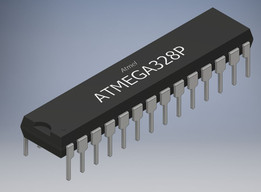
Atmega328P PINs
There are different models of the Atmega328P, yet its pin layout is a consistent access point for its functions. This microcontroller is equipped with 28 different pins, each assigned a specific role, ranging from power supply to handling analog input signals.
Atmega328P has 28 PINs, All PINs of atmega328P Are listed in the table shown in the figure below.
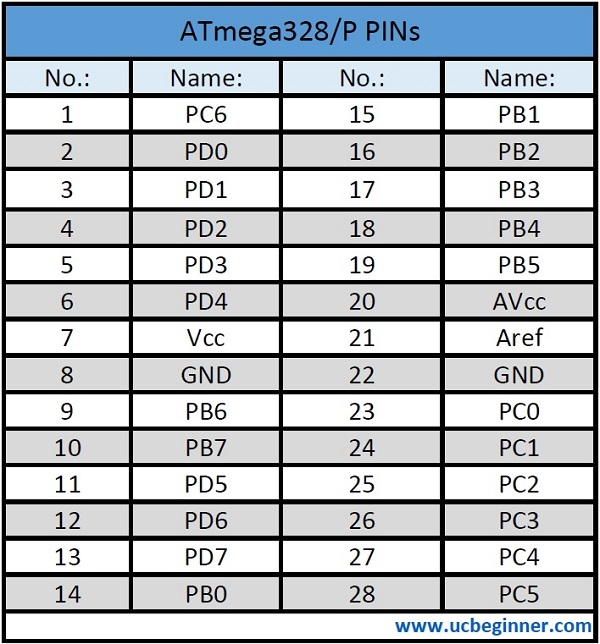
Atmega328P Pinout
Below is the pinout schematic for the Atmega328P, illustrating the microcontroller‘s pin configuration. When dealing with the Atmega328P, it is important to familiarize yourself with the pin layout as shown in this diagram.
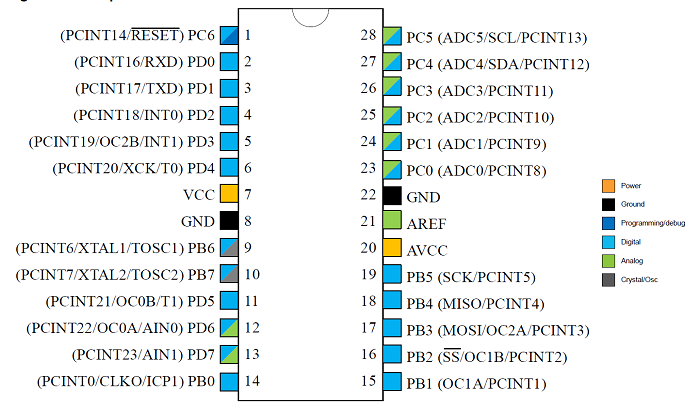
PIN Description
Each pin on the Atmega328P is associated with separate functionalities, which are essential for operation during project development with this microcontroller. The pins of the Atmega328P are divided into three main ports, each with unique characteristics.
- Port B includes eight pins labeled PB0 through PB7. It is an 8-bit bidirectional I/O port, complete with built-in pull-up resistors for each pin.
- Port C also consists of eight pins, designated PC0 through PC7, offering additional connectivity options.
- Finally, Port D has another set of eight pins, PD0 to PD7, acting as an 8-bit input/output port like Port B.
Atmega328P Features
The Atmega328P stands out in the microcontroller market with its advanced RISC architecture, optimizing both energy consumption and processing power. This microcontroller is designed for efficiency and adaptability, as evidenced by its array of functions:
- Efficient and powerful 8-bit AVR microcontroller: Engineered to balance operational speed with power conservation.
- Refined RISC architecture: boasts a suite of 131 robust instructions, most of which are executed in a single clock cycle for high-speed performance.
- UART: Supports two-way serial communication, establishing a protocol for interaction between microcontrollers and computers.
- SPI: Known for fast data transfer, this master-slave serial protocol is widely implemented for short-range communications in embedded systems.
- I²C: This is a versatile bus system capable of multi-master, multi-slave communication, used to connect low-speed peripheral ICs to processors and microcontrollers.
- Memory Allocation: Comes with a selection of self-programmable flash program memory from 4 to 32K bytes with EEPROM and onboard SRAM.
- Comprehensive peripheral integration: includes a variety of timers/counters, pulse-width modulation (PWM) channels, analog-to-digital converter (ADC) channels, a real-time counter, and multiple communication interfaces, including USART, SPI, and a Is. Wire-serial interface for better functionality.
- Special Functional Attributes: It includes capabilities such as power-on reset, brownout detection, a precisely calibrated internal oscillator, and several modes to conserve power during idle times.
- Flexible Input/Output and Package Variation: Provides 23 programmable input/output lines and is offered in an assortment of package types such as PDIP, TQFP, and QFN/MLF.
- Applicable Power Requirements: Operates on a variable voltage range from 1.8V to 5.5V depending on the specific model.
- Operational Temperature Spectrum: Operates over a wide temperature range from -40°C to 85°C.
Atmega328P Instruction Set
The Atmega328P microcontroller operates on a streamlined suite of operations known as its instruction set. These operations are engineered on a Reduced Instruction Set Computing (RISC) framework, which enhances the simplicity and agility of command processing. The majority of operations within the Atmega328P’s repertoire are executed within a singular clock cycle. This quick processing capability is advantageous, especially in scenarios where swift reaction times are paramount.
Below is a compilation of operations from the Atmega328P Instruction Set:
- Addition without carry-over (ADD)
- Addition with carry-over (ADC)
- Subtraction without carry-over (SUB)
- Subtraction with carry-over (SBC)
- Immediate addition to a word (ADIW)
- Immediate subtraction from a word (SBIW)
- Logical conjunction (AND)
- Immediate logical conjunction (ANDI)
- Inclusive disjunction (OR)
- Immediate inclusive disjunction (ORI)
ATmega328P Registers
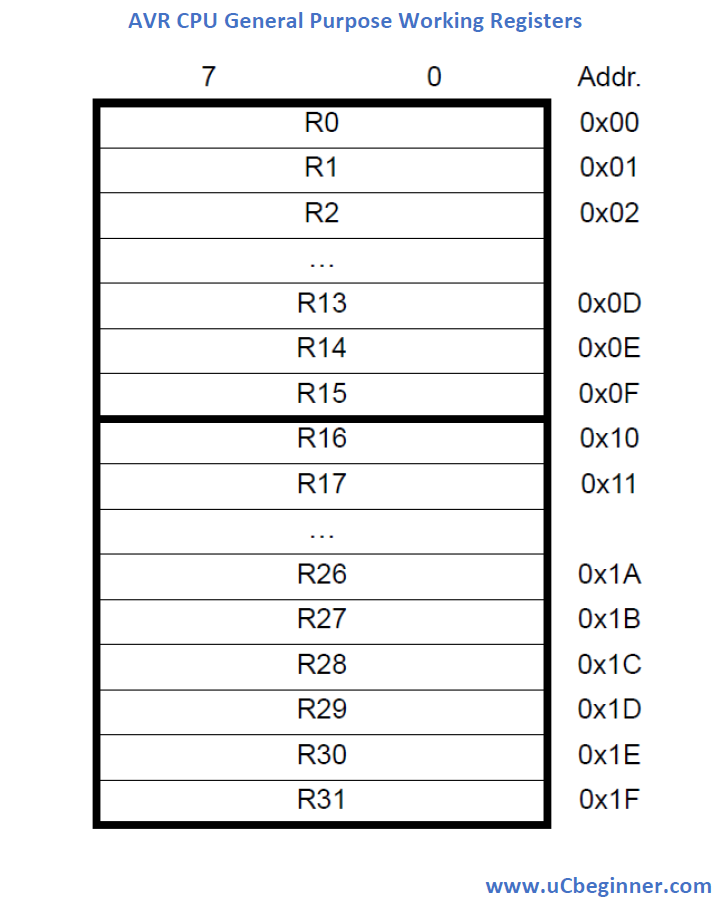
Each register is also assigned a data memory address, mapping them directly into the first 32 locations of the user data space. Although not being physically implemented as SRAM locations, this memory organization provides great flexibility in access to the registers.
Atmega328P Bootloader
The Atmega328P microcontroller’s bootloader is a basic piece of software embedded in its permanent memory, which serves as the initial stage for implementing additional software. Its main function is to prepare the microcontroller for operation, making it possible to directly upload external programming devices without code. At startup or when the Atmega328P undergoes a reset, this bootloader checks for the presence of incoming software. If there are any, it diligently writes new instructions into the microcontroller’s flash memory, setting the stage for software execution. This integral program is the cornerstone of the user-friendly experience provided by platforms such as Arduino, where the Atmega328P is widely used, thereby facilitating iterative development cycles across multiple applications.
ATmega328P Packages
Packages are mean different versions of the same device, Each package has different dimension and PINs, The package of ATmega328 are shown in the table is given below figure.
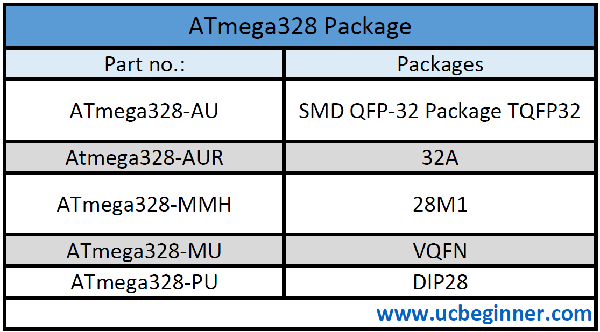
Atmega328P-AU: The Compact SMD Option
The Atmega328P-AU distinguishes itself within the Atmega328P microcontroller lineup as a sleek, surface-mount model that provides a design-friendly option, adept at conserving space while maintaining full feature access. Its reduced height is particularly beneficial in the realm of complex PCB layouts, promoting optimal use of space and smooth integration into end-user products. The Atmega328P-AU facilitates easy transition from early prototype stage to large-scale manufacturing, combining its compact construction with consistent, robust operation for which the family is respected.
Atmega328P-PU: The DIP Package
The Atmega328P-PU stands out as a through-hole model within the Atmega328P lineup, enclosed in a dual in-line package (DIP). This layout is perfect for breadboard experiments and teaching use, thanks to its user-friendly design that facilitates easy insertion and manipulation. The DIP structure enables hobbyists and teachers to quickly operate and adjust circuits, offering a solid, interactive approach to education and prototype development.
How to start with atmega328P’s Arduino [Learning Tips]
Getting Started Programming on Atmega328P Arduino
Like its microcontroller brethren, the Atmega328P must be programmed with software to function. It is compatible with two programming environments: Arduino IDE and Atmel Studio. Using the Arduino IDE, a simple USB cable is sufficient for programming, while Atmel Studio requires an Atmel ICE programmer that connects via the ICSP pins on the Arduino board.
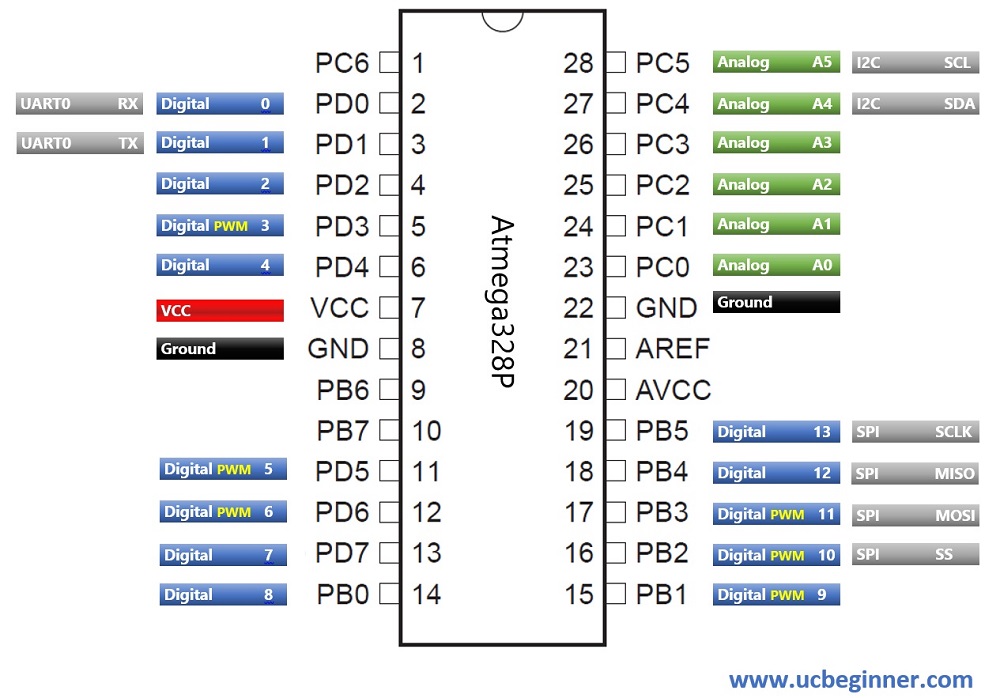
Here are some strategies to consider:
First, consider starting with an Arduino Uno board instead of a standalone Atmega328P. The Uno board comes with the necessary circuitry, which simplifies the programming process. However, it is beneficial to familiarize yourself with the Uno’s schematic to fully understand its operation.
Secondly, for those who intend to excel in the microcontroller domain, take interest in register level programming instead of relying on Arduino IDE’s libraries. While the IDE’s libraries are convenient for quick tasks, register-level programming provides a deeper understanding and expertise for professional microcontroller programming.
Conclusion
In conclusion, the Atmega328P microcontroller stands out for its adaptable nature, offering a straightforward approach for newcomers to experienced creators with comprehensive features. Becoming familiar with its pinout, mastering its instruction set, and taking advantage of its full range of functions can open doors to a wide range of electronic and programming ventures. It is important to recognize that practical engagement and progressively challenging projects are the foundation of mastery. Equip yourself with the Atmega328P, and embark on a journey of technological creativity.
Should you have any questions, feel free to post them in the comment section below.

Port c only has 7 pins PC0-PC6, not eight.